Close, very close to heaven. On the holy mountain of Pektu-san - where the Korean freedom fighters set up a bastion of resistance against the Japanese - at dawn on February 16, 1942, a new sun shone on the martyred country. In a wooden hut, the Mother of Korea, Kim Jong Suk, gave birth to a child. Although there were no three kings or shepherds, there was ... a lot of propaganda!
At the news of the birth of the son of the beloved leader and general Kim Il Sen, the hearts of the companions in arms beat joyfully and their eyes are filled with tears of happiness. Here is a new hope descended on them at the top of Pektu-san. For the work of the Great Leader was safe from then on. A few more years and his newborn heir will grab a rifle himself and continue the fight for freedom. In a cold camp, amid the terror of the fight against the occupier, Kim triumphs.
And the events are, of course, accompanied by magic signs:a double rainbow and a completely new star in the sky, indicating the birthplace of the son of the divine race. So much for the propaganda vision served to the world by North Korea. The reality didn't look as sweet.
He, she and the revolution
Kim Jong Suk took up arms at the age of fifteen. Her mother and stepmother died at the hands of the Japanese, and she herself decided to sacrifice her life to fight the occupier. She volunteered for the Children's Battalion, commanded by Kim Il-sung.
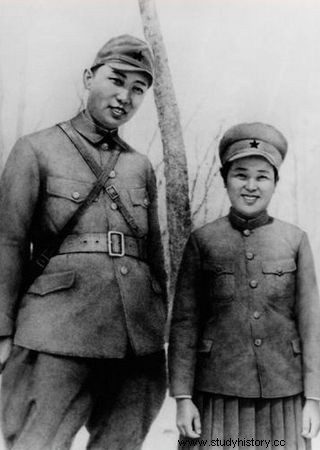
"Wedding Photography" by Kim Il Sena and Kim Jong Suk.
Initially, she was an unremarkable subordinate to her superior. The situation changed in the summer of 1937, when the Japanese found matrices ready for printing propaganda leaflets at Dzong Suk.
The fate of the young guerrilla at that moment seemed doomed. Instead of grieving over the life that she was about to lose, she addressed her companions with words to encourage them to fight - I will die, but you must not give up! The attitude of the girl (as long as these events were not made up) must have made quite an impression on the commander.
Little is known about the beginnings of their life together. Almost nothing gets through the sieves of North Korean censorship, and there may be at most a small grain of truth in the available propaganda material. What is certain, however, is that Kim Il-sung devoted himself primarily to the guerrilla movement and the revolution, and family life was much lower on his list of priorities.
According to Diane Ducret, author of "Women dictators 2", in 1941 it was only the persuasions of other women living in the camp that prompted the Beloved Chief to take a photo of himself with Dzong Suk. Kim Il-sung himself recalled:
When she found out about it, she turned beet red and hid behind the women's backs. They, however, pushed her towards me with a smile. The companion wasted no time, pressed the shutter in no time. It was the first time in my life that I posed for a photo with a woman. Dzong Suk and I actually treated it like a wedding photography. (quoted after:D. Ducret, "Women of dictators 2")

According to North Korean propaganda, Kim Il-sung spent the entire war fighting the Japanese. In fact, he spent most of it in the Soviet Union. The illustration shows one of the many propaganda posters depicting Kim Il-sung among the partisans.
What was the little successor of the Sun of the Revolution doing at that time? Well, he was born in the same spring, when his parents' "wedding photo" was taken. Except on the occasion of his birth, flowers did not bloom in the middle of winter, nor did the birds sing praises, joyful songs in his honor, and there was no double rainbow across the sky.
In addition, not only Dzong Suk did not give him to Pektu-san, but did not even do so in the officially reported year. But what is not being done for better PR?
Where were the parents?
In fact, during the Second World War, Kim Il-sung served in the Red Army as a major, commanding a detachment made up of his countrymen. Absorbed in the heat of the revolution, he did not have much time for Dzong Suk. Meanwhile, she was doing her best, obsessively, to gain Kim's favor.
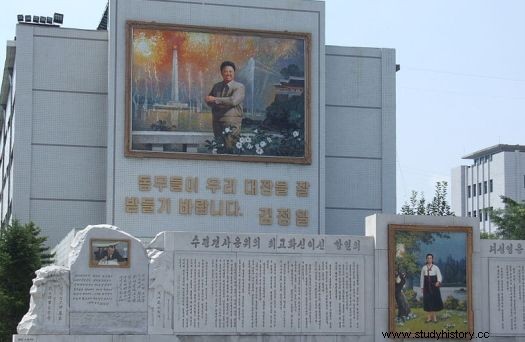
One of the North Korean monuments showing Kim Il-sung in a central place, and at his feet (probably like in real life) Kim Jong Suk.
By today's standards, we would probably call her… bizarrely committed culture animator. As Diane Ducret writes, Dzong Suk prepared dance performances for soldiers and Koreans living under the Japanese occupation, convincing them, among other things, to such an important civic duty as repairing roads.
At the same time, it did not allow women to be reduced to the role of only "time-loving" for partisans. Her companions, inspired by her and thanks to her initiative, even learned to jump with a parachute and cross rivers in full gear while going with the flow.
Jong Suk's blind eyes to Kim was also evidenced by the fact that she was ready to lie about the birth of her son. The successor of Kim Il-sung was born outside Korea. The country of his birth was the Soviet Union, which in a way spoiled the ideal image of the great Leader's successor.
For propaganda purposes, information was spread that the child was born on the aforementioned holy mountain. The birth in the Soviet military camp in Viatskoye on the Amur somehow did not fit in with the life of the future divine leader ...
Not only the official place, but also the given year of birth is not true. In fact, Kim Jong-il was born in 1940 or 1941. He was slightly rejuvenated, again because of propaganda. After all, the celebration of future double round jubilees - father and son (Kim Il-sung was born in 1912) - must have been wonderful!
Madmother?
Before the time to celebrate, however, Korea had to be liberated, so Kim's soldiers could not rest on their laurels yet. The partisans marched among the mountains and forests, enduring the hardships. During one of these strenuous marches, on a cold October evening, Kim Jong Suk once again decided to prove her devotion to the Great Commander.
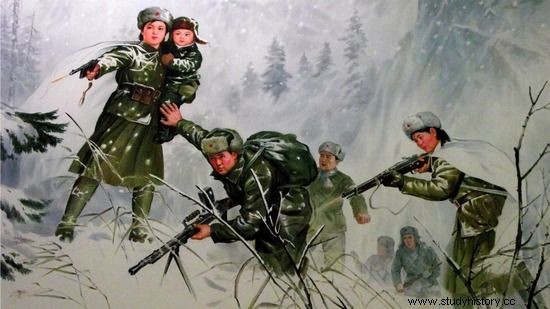
Both the place and date of birth of Kim Jong-il were changed for propaganda purposes. What's more - as you can see in the attached picture - little Kim took part in the fights with the Japanese.
Holding Kim Il-sung's underwear in her hands like a relic, she ran quickly over the stream to refresh what was closest to the body of the great commander. The conditions did not allow her only to dry the chief galatos before continuing her journey, which made her almost despair . She couldn't carry Kim's wet things in her backpack, and she couldn't hand them back to him unprepared.
Driving away the specter of failure, she tucked her wet underwear under her jacket and dried it on her body as she walked. Let us remind you - it was a cold October night, so she had to shiver from the cold all the time and rub her ragged hands in the stream. Meanwhile, when proudly handed her husband fresh underwear during the next stop, she was reprimanded by him.
After a while, however, seeing her commitment and effort put into giving him this little pleasure, the chief changed his mind and - as Diane Ducret writes - shed a few tears. If this symptom of attachment seems quite eccentric, the next one is downright bizarre.
As Kim Il-sung prepared for his next mission, Jong Suk's dream was spent making his march more comfortable and his dress more pleasant. Finally she had a brilliant (probably only in her opinion) idea.
She decided to get the commander new, soft insoles. The obstacle was the lack of appropriate materials. However, the obsession of a woman, with the help of what nature had given her, overcame this obstacle as well.
The revolutionary leader Kim Il-sung must have reacted in an interesting way when, while putting on his shoes, he found inserts made of his wife's jet-black braids. It is a pity that such memorable moments in the life of the leader were not recorded by the camera shutters ...
Have a nice nice life…
Jong Suk, which became Kim's shadow, was finally able to breathe only in 1945, when her husband became the "Sun of Korea". It does not matter that he was chosen not by Koreans, but by the Soviets, and that he was chosen because of the lack of better candidates (and he was the least educated leader of the communist bloc). All that mattered was that a new Communist Korea had emerged with Kim Il-sung at the helm.
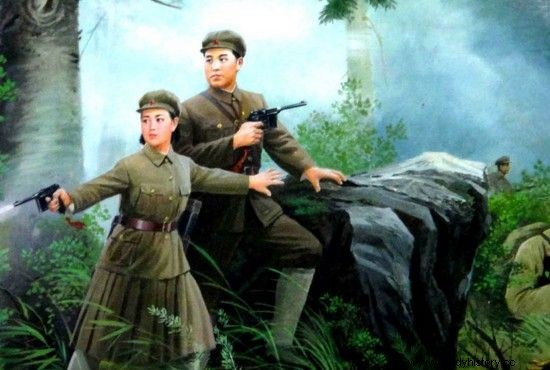
Another show of the possibilities of North Korean propaganda. Kim Ir Sen and Kim Jong Suk ready to fight the Japanese. As we know, they were actually in the USSR at that time.
With the move to Pyongyang, the Kims turned the guerrilla hut into a beautiful villa with a swimming pool and quickly decided to enlarge the family. For two years there are other descendants - son Szura, and then daughter Kim Kyong-hui. The idyll with the leader leading the people towards the revolution and the patter of little feet on the terrace does not last too long. As early as 1948, the world of Dzong Suk is collapsing.
Little Shura running around the house will disappear from Mother's sight for a moment. Moments later, Dzong Suk finds him dead in the pool . This gigantic blow to the mother's heart completely breaks Korea's First Lady. He no longer regains his health and mental balance. In 1949, Dzong Suk is thirty-two years old and has the face of a much older woman.
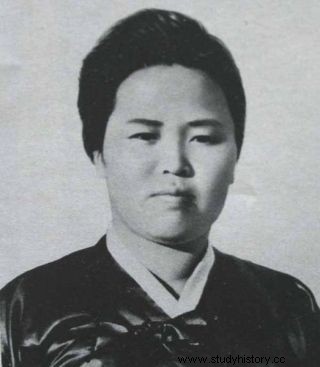
Kim Jong-Il's mother was quite specific…
Years of guerrilla warfare weakened her strength, and Shura's death completely shattered her psyche. The organism was too weak to survive the hardships of another childbirth. The chief's wife died on September 22, 1949, giving birth to a dead daughter.
There are some assumptions that Dzong Suk committed suicide, or was removed from the commander's circle as not very representative (illiterate and destroyed for years in the guerrilla warfare).
We will never know the true causes of death. This is not the first and not the last closely guarded secret of a state ruled by her grandson Kim Jong Un. However, the peculiar myth of the birth of the great Kim Jong-il will remain after it. A real Pectus nativity scene.
Source:
- Diane Ducret, Women Dictators 2 , Znak Social Publishing Institute, Krakow 2013.
